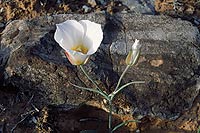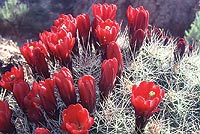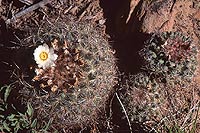 If you had to think of one plant that represents the desert landscape, what would it be? Sego lily for its beauty and State Flower of Utah status? Perhaps the Utah juniper with its twisted trunk and gnarled limbs? How about Fremont’s cottonwood for its stately stature and summer “snowfall” of seeds? To me, it would be one of the different species of cacti that grow in the Canyonlands region because of their resilience to drought, their colorful ephemeral bouquet of flowers, and their spiny piercings.
If you had to think of one plant that represents the desert landscape, what would it be? Sego lily for its beauty and State Flower of Utah status? Perhaps the Utah juniper with its twisted trunk and gnarled limbs? How about Fremont’s cottonwood for its stately stature and summer “snowfall” of seeds? To me, it would be one of the different species of cacti that grow in the Canyonlands region because of their resilience to drought, their colorful ephemeral bouquet of flowers, and their spiny piercings.
For any desert plant, losing moisture to the atmosphere through photosynthesis or at other times can prove fatal. Long ago, cacti shed the structural ability to grow leaves. Instead, the waxy-coated stems store chlorophyll pigments that drive the process of photosynthesis. Though cactus spines deter some herbivores, the spines also provide some micro shade on the stems, as well as breaking up desiccating winds which can draw moisture out of leaves.
To minimize moisture loss to the air during photosynthesis, a cactus stem shuts down their tiny windows or stomata during the day. At night, when the air is cooler and moisture loss (transpiration) to the atmosphere is lower, the stomata open and carbon dioxide flows into the stem’s cells while oxygen, a byproduct of photosynthesis, is released. The plants use this stored carbon dioxide to power their unique photosynthetic pathway called CAM or Crassulacean Acid Metabolism during the day. 
Here are a few of the common cacti found in the Canyonlands region.
Claretcup (Echinocereus triglochidiatus) is one of the first cacti to bloom in spring. The common name refers to the red, goblet-like flowers which attract hummingbirds as pollinators. The scientific name Echinocereus is from the Greek echinos, meaning “hedgehog” after the resemblance of these barrel-shaped stems to the spiny animal. Triglochidiatus refers to the clusters of three-straight spines that arise from a common point.
Another early barrel-shaped cactus that grows in desert shrub and pinyon-juniper woodlands is the Whipple’s fishhook (Sclerocactus whipplei). The genus name refers to the hooked spines and the species name honors Amiel Wicks Whipple (1818-1863), a Civil War brigadier general and interim chief surveyor for the U.S. Topographical Engineers survey of the United States and Mexico boundary from 1853-1856. The purplish flowers encase numerous stamens and a center cluster of pistils and are visited by bees and hummingbirds as pollinators.
A low-growing, pin-cushion shaped cactus called Simpson’s pincushion cactus (Pediocactus simpsonii) grows at higher elevation (up to 11,500 feet!) and has small white, yellow-green, yellow, or magenta-colored flowers.

Of all the cacti that grow in the Canyonlands region, the prickly-pear cactus is the most abundant and easily observed. There are several different species and varieties of these Opuntia, a name bestowed upon them after a different spiny, non-cactus plant that grew in the ancient Greek village named Opus.
Unlike the barrel-shaped cacti, the prickly pears have flattened pads that are covered with various amounts of spines. The flowers vary in color from yellow to magenta and last about a day. Numerous bees may be viewed wandering through the forest of stamens collecting pollen and completing the process of pollination. Later in summer, the reddish fruits, called “tunas”, are eaten by wildlife or humans – just watch out for the little tiny spines on the fruits.
All these cacti have shallow corky-roots which spread laterally just beneath the ground. This way the rootlets can quickly absorb rainfall that moistens the ground; cacti can even grow “rain roots” which grow when the soil is wet, then die back as the soil dries up. Just one of many adaptations of these desert-dwelling plants.